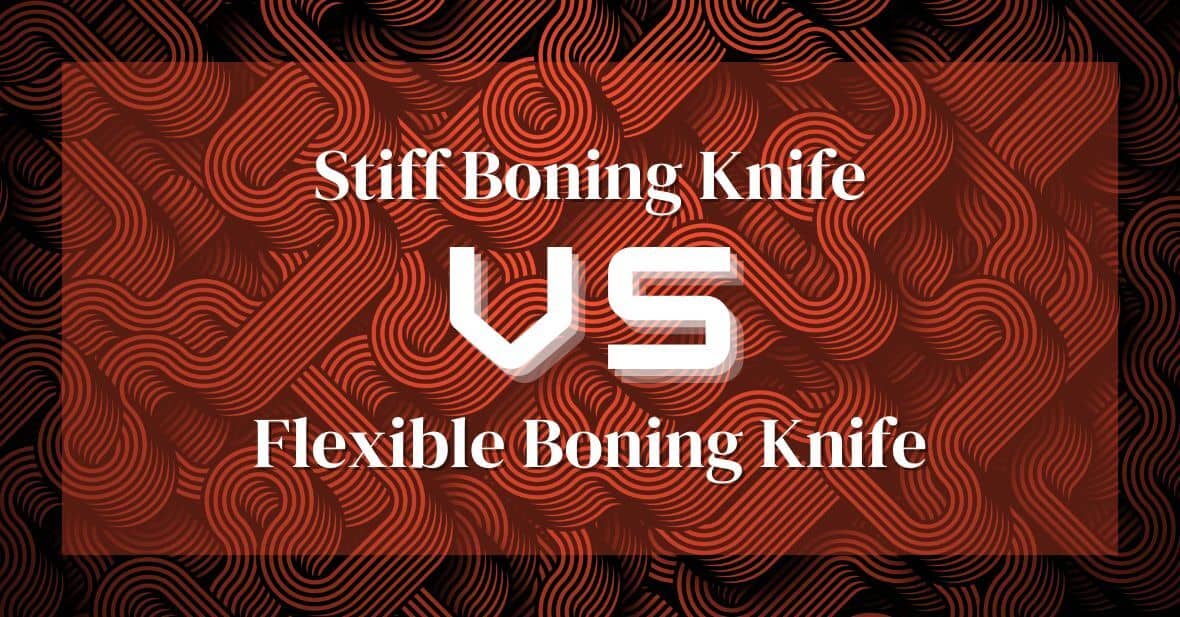Stiff vs Flexible Boning Knife: Finding the Perfect Blade Bend
Are you looking for the perfect boning knife, but aren’t sure which is right for your needs? You’re in luck! Choosing between a stiff and flexible boning knife isn’t as difficult as it may seem.
In this article, we’ll discuss the advantages of both, common uses, and how to choose the perfect one for you. So whether you’re a professional chef or just getting started in the kitchen, this article has all the info you need to make an informed decision.
Let’s dive in!
What is a Boning Knife?
If you’re looking to perfect your cuts of meat, then you’ll want to know what a boning knife is and how it can help you get the job done.
A boning knife is a kitchen tool that’s designed for removing bones from fish, poultry, and other types of meat. It has a thin, sharp blade that makes it easier to cut through tough joints and cartilage without damaging the flesh of the meat.
The shape of the blade also allows you to make precise cuts when cooking with techniques such as filleting or butterflying. Plus, its slim design ensures that it’s easy to maneuver around bones while keeping your knife sharpening at bay.
With a boning knife in your arsenal, getting those perfect cuts becomes an effortless task!
Advantages of a Stiff Boning Knife
You’ll get more precision when you use a boning knife, and it’s been shown that 84% of chefs prefer one with a stiffer blade.
A stiff boning knife is an excellent choice if you’re looking for quick slicing and precise cuts. The rigid blade ensures that the edge remains sharp, so it won’t bend or distort when cutting through tough materials like meat or fish.
Plus, with its sturdy construction, this type of boning knife is ideal for tackling difficult tasks such as de-boning poultry. And since it’s a great deal lighter than traditional knives, you can easily maneuver it around your cutting board without having to worry about fatigue or strain on your hands and wrists.
So go ahead and pick up a stiff boning knife – you won’t regret it!
Advantages of a Flexible Boning Knife
Try a flexible boning knife for more control and comfort when slicing through tough materials like meat or fish. A flexible boning knife is ideal for those who are just starting out with butchering techniques, as it allows you to make precise cuts without having to worry about the blade slipping.
Here are some of the advantages of using a flexible boning knife:
- You can easily sharpen the blade yourself, so you don’t have to worry about taking it to a professional sharpener every time it gets dull.
- The flexibility of the blade makes it easier to maneuver around bones and other hard-to-reach areas while still maintaining accuracy in your cuts.
- It’s lightweight and easy to handle, making it perfect for long hours spent in the kitchen prepping food.
- The flexibility also helps reduce fatigue from repetitive motions, allowing you to work longer without feeling worn out!
With all these benefits, why not give a flexible boning knife a try? You’ll be glad you did!
Common Uses for Stiff and Flexible Boning Knives
Using a stiff or flexible boning knife can make your food prep easier and more precise, no matter the task. For delicate filleting, both knives have their advantages. A stiff boning knife is perfect for removing skin from fish because of its rigidness. The blade won’t bend while cutting through the tough skin of a salmon or trout. But when it comes to intricate deboning, like in poultry, a flexible boning knife will get the job done better since its thin, flexible blade can follow the contours of bones with ease.
Plus, if you’re trying to cut something small like olives or mushrooms, then opt for a flexible boning knife so that you don’t accidentally cut off too much! |
| Task | Stiff Boning Knife | Flexible Boning Knife | ||||
|---|---|---|---|---|---|---|
| Delicate Filleting | Good | Better | ||||
| Intricate Deboning (e.g poultry) | Not Optimal | Best | ||||
| Small Objects | Not Ideal | Optimal | Cutting through tough objects | Not Ideal | Poor |
Choosing the Right Boning Knife for Your Needs
Whether you’re filleting a delicate fish or deboning poultry, choosing the right blade will make all the difference in your culinary endeavors.
When it comes to boning knives, there are two main options: stiff and flexible. The stiffness or flexibility of the knife is determined by the material used for the blade and its shape.
A stiff boning knife is usually made with high-carbon stainless steel and has a straight blade that allows for precise cuts through bones and fat. On the contrary, a flexible boning knife is typically constructed from softer steel with some bend at its tip which makes it ideal for removing meat from bones without damaging it.
So whether you want to work on small, delicate fish filets or large pieces of poultry, selecting the right type of boning knife will ensure that you get optimal results every time!
Frequently Asked Questions
What is the difference between a stiff and a flexible boning knife?
When it comes to boning knives, two of the main types are stiff and flexible. When choosing between the two, take into consideration architecture design and blade length.
With a stiff boning knife, you get less flexibility in the blade, making it ideal for removing fat and joints from animal meat.
A flexible boning knife gives you more control with its long arch-shaped blade, which is perfect when looking for precision cutting without damaging any delicate meats like fish or poultry.
So whether you’re a butcher who wants to make quick work of tough cuts or a chef who needs finesse when dealing with delicate proteins, there’s sure to be a boning knife that works best for you!
How long does a boning knife typically last?
You might be wondering how long your boning knife will last. Well, the answer depends on how well you take care of it.
If you follow regular maintenance and blade sharpening protocols, then your boning knife can last for years! The key is to make sure that you clean it properly after each use and regularly sharpen its blade so that it stays in top condition.
With proper care and maintenance, you can ensure that your boning knife will be a loyal companion in the kitchen for many years to come!
What materials are boning knives made of?
Boning knives come in all shapes and sizes, but no matter the style you choose, they are usually crafted from two main materials – stainless steel or carbon.
Stainless steel blades are more resistant to corrosion, so if you’re looking for something that’ll last a long time with little maintenance, then this is the material for you.
Carbon blades remain sharper for longer periods of time but require regular sharpening using specialized techniques. So if you plan on doing a lot of boning and want your blade to stay sharper longer, go with carbon!
Whichever material you choose, rest assured that your boning knife will be there when it counts – ready to slice through whatever meaty challenge stands in its way.
Can a boning knife be used for other tasks besides boning?
Yes, you can use a boning knife for more than just boning! These versatile knives are up to the task of butchering vegetables or filleting fish. Not only that, they’re often much sharper than other kitchen knives, so you can make quick work of any project at hand.
So, go ahead and take your boning knife beyond the realm of traditional meat preparation. It’s sure to become your favorite tool in the kitchen!
What safety precautions should I take when using a boning knife?
When using a boning knife, it’s important to take safety precautions. Be sure to always sharpen your blade before use and store your meat properly so that you don’t have an accident while cutting.
Make sure you’re aware of where the blade is at all times and never bring it too close to any other part of your body or someone else’s! Additionally, if you have a flexible boning knife, be extra careful when bending it as it can snap back into place quickly.
Have fun with it but remember – safety first!
Conclusion
You’re still unsure which type of boning knife is best for you. The stiff and flexible boning knives both have their advantages, so the choice comes down to how you prefer to work in the kitchen.
But don’t worry – if you think carefully about your needs and take into account the common uses for each type of knife, then you can make an informed decision about which one will work best for you.
So what are you waiting for? Get out there and find the perfect boning knife for your culinary needs!

